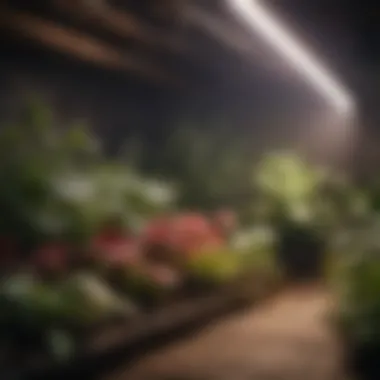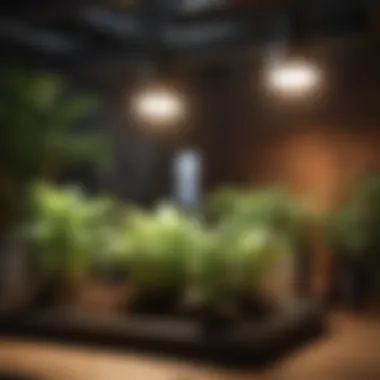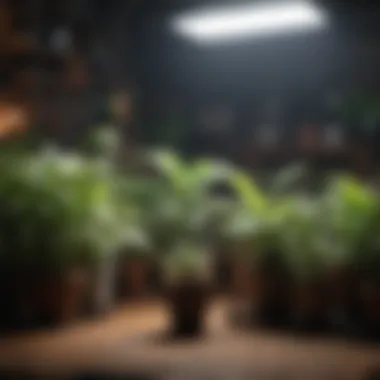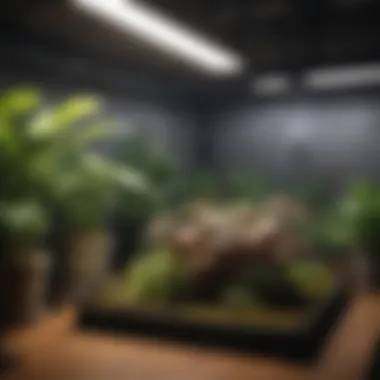Maximizing Efficiency in Your Grow Light Setup


Intro
In the realm of indoor gardening, the right grow light setup is crucial for healthy plant growth. This guide explores the optimization of grow light systems, emphasizing components, energy efficiency, and strategic layout. Understanding these elements can lead to better yields and healthier plants, both for hobbyists and professionals alike.
Understanding Grow Light Types
When configuring a grow light setup, it is vital to consider the various types available. Each type has unique features, energy demands, and efficiencies. Some common options include:
- LED Lights: Known for their low energy consumption and long lifespan, LED lights are a top choice for many growers. They emit specific wavelengths beneficial for plant growth, making them efficient.
- HID Lights: High-Intensity Discharge lamps, such as Metal Halide and High-Pressure Sodium lights, are popular for their intense brightness. However, they produce more heat and consume more energy.
- Fluorescent Lights: While not as powerful as LEDs or HID lights, fluorescent grow lights are cost-effective and ideal for seedlings and small plants.
Choosing the right type of light is foundational for an efficient setup.
Key Components of Grow Light Setup
A successful grow light system includes several key components:
- Light Spectrum: Plants need different light wavelengths at various growth stages. Blue light promotes vegetative growth, while red light supports flowering.
- Light Placement: Correct height and angle adjustments enhance coverage. Lights should be close enough to provide adequate intensity but not so close that they cause heat stress.
- Reflectors: Using light reflectors can amplify light efficiency. They help direct light towards plants instead of allowing it to escape into the surroundings.
Incorporating these elements leads to more effective light exposure, therefore maximizing plant growth potential.
Energy Consumption Considerations
Energy usage of grow lights can significantly impact operational costs. Selecting energy-efficient fixtures is crucial, not just for savings, but also for sustainability. To manage energy effectively:
- Evaluate the wattage and energy ratings before purchase.
- Implement timers or smart controls to ensure lights are only on during necessary hours.
- Consider using solar panels or other renewable energy sources if possible.
Making informed choices about energy consumption ultimately leads to a more sustainable indoor gardening practice.
Layout Strategies for Grow Lights
Proper layout strategies ensure that plants receive equal light distribution. Some strategies include:
- Grid System: Organize lights in a grid, ensuring even coverage across all plants.
- Plant Height Management: Arrange plants of similar heights under the same light source to maximize efficiency.
The design of the layout should reflect the specific needs of the plants being grown.
Ending
Optimizing a grow light setup involves careful consideration of various factors. Selecting the right type of light, understanding energy consumption, and employing effective layout strategies are all vital. By implementing these considerations thoughtfully, indoor gardeners can enhance their cultivation efforts and achieve better results.
This guide serves as a foundation for growers looking to improve their indoor gardening practices.
Understanding Grow Lights
Understanding grow lights is a fundamental aspect of indoor gardening and agriculture. Proper knowledge of these lights aids in plant growth, reduces energy consumption, and maximizes yield. Grow lights simulate sunlight, which means understanding their specifics can lead to healthier plants and better harvests.
Grow lights vary widely in type and function, making it crucial for growers to grasp their unique characteristics. This section examines what grow lights are and the reasons for using them in various settings.
What are Grow Lights?
Grow lights are artificial light sources designed to support plant growth. They provide necessary wavelengths of light that plants require for photosynthesis. Photosynthesis is a critical process for plant development, as it enables them to convert light energy into chemical energy, thus supporting growth and development.
The primary function of grow lights is to supplement natural light when conditions are inadequate. They can be used in various environments including homes, greenhouses, and commercial farms. Different types may offer distinct light spectra, heat outputs, and energy usage, catering to various plant species and growth stages.
Why Use Grow Lights?
The use of grow lights is indispensable for indoor gardening and agricultural practices. There are several compelling reasons to incorporate them into your plant care routines:
- Year-Round Growth: Grow lights enable plants to thrive regardless of seasonal changes. This capability allows growers to cultivate plants throughout the year.
- Controlled Conditions: Using grow lights provides growers with the ability to manage light intensity and duration, thus creating optimal conditions tailored for specific plants.
- Improved Yield: When used correctly, grow lights can significantly increase the productivity of gardens, leading to more abundant and healthier plants.
- Versatility: Grow lights can support a wide range of plant types, including vegetables, herbs, and ornamental plants, making them suitable for numerous applications.
In summary, understanding grow lights is essential for optimizing indoor growing efforts. With appropriate application, growers can enhance plant health, increase yield, and cultivate a predictable crop cycle.


Types of Grow Lights
Understanding the types of grow lights is crucial for maximizing indoor gardening efficiency. Each type has unique features that influence plant health, energy consumption, and cost-effective operation. Choosing the right grow light can directly affect the growth rate, yield, and overall vitality of plants. By delving into various types, one can make informed decisions that suit specific gardening needs.
LED Grow Lights
LED grow lights have gained significant popularity in indoor gardening. Their energy efficiency is a standout feature. These lights consume less power, meaning lower electricity costs for the grower. Another important aspect is the spectrum of light emitted. LED lights can be customized to emit specific wavelengths of light that are beneficial for plants. This targeted approach facilitates stronger growth and better yields. Additionally, LEDs have a long lifespan, reducing the need for frequent replacements, which also contributes to lower costs over time. However, the initial investment may be higher compared to other types, but the long-term savings often justify this expense.
Fluorescent Grow Lights
Fluorescent grow lights are another common choice. They are especially well-suited for seedlings and young plants. One of their benefits is that they produce a soft light that is not too harsh on delicate growth. This is ideal for the initial stages of plant development. These lights are also lightweight and easy to set up, offering flexibility in positioning. However, fluorescent lights are generally less efficient when it comes to light penetration compared to LEDs. They also have a shorter lifespan than LED options, which can lead to more frequent replacements. Overall, they provide a good balance between cost and effectiveness, particularly for beginners.
HID Grow Lights
HID grow lights are powerful options primarily used in larger setups or professional systems. They have two major variants: Metal Halide (MH) and High-Pressure Sodium (HPS).
MH (Metal Halide)
Metal Halide lights are well-known for their balanced light spectrum. They produce a bluish light that closely mimics natural sunlight. This quality is beneficial during the vegetative growth phase of plants. The key characteristic of MH lights is their ability to promote leafy growth. However, they generate a significant amount of heat, which can be a problem if not managed properly. Growers often need to ensure adequate ventilation when using these lights. Despite this challenge, their ability to support healthy plant growth makes them a popular choice.
HPS (High-Pressure Sodium)
High-Pressure Sodium lights are primarily favored during the flowering phase of plant growth. They emit a warm, yellowish light that encourages blooming and fruiting. One significant aspect of HPS lights is their high efficiency in converting electricity into usable light, leading to brighter output with less energy use compared to MH lights. However, like MH lighting, HPS options also produce excessive heat that must be managed carefully. Their effectiveness in promoting robust yields makes them a staple in many commercial grow operations, despite the heat considerations.
Incandescent Grow Lights
Incandescent grow lights are less commonly used due to their inefficiency and high heat output. While they can be found in some setups, they are generally not recommended for serious growers. Their energy consumption is higher compared to LEDs, and their lifespan is significantly shorter. Additionally, they emit too much heat, risking damage to plants. Incandescent lights are more suited for accent lighting rather than as primary grow sources. Thus, for effective indoor gardening, it's advisable to explore the other types more thoroughly.
Key Features of Efficient Grow Lights
The selection of grow lights is pivotal for indoor gardening success. Understanding the key features of efficient grow lights can significantly affect plant health, energy consumption, and overall yield. Efficient grow lights not only provide essential light for growth but also optimize energy usage, ensuring that growers achieve the desired results without excessive costs. Below are critical aspects that can guide your choices.
Wavelength and Spectrum
Plants rely on specific wavelengths of light for photosynthesis and development. Grow lights that provide a balanced spectrum, especially in the blue and red wavelengths, are essential. Blue light, typically in the range of 400-500 nanometers, is crucial for vegetative growth, fostering robust foliage. Conversely, red light, around 600-700 nanometers, promotes flowering and fruiting.
Different grow lights offer varying spectrums. For example, LED grow lights can be designed to emit specific wavelengths, thus providing tailored lighting based on the plant's growth stage. This adaptability not only encourages healthy growth but also enhances energy efficiency, as the plants receive precisely what they need.
Energy Efficiency
Energy efficiency is a vital consideration when selecting grow lights. Efficient models like LED lights consume significantly less energy compared to traditional incandescent or even fluorescent lights. This translates to lower electricity bills and enhanced sustainability in your gardening practices.
Moreover, energy-efficient grow lights tend to produce less heat. This not only minimizes cooling needs but also reduces the risk of plant stress due to excessive temperatures. In a long-term perspective, investing in energy-efficient systems can lead to substantial savings while ensuring optimal plant growth conditions.
Lifespan and Durability
The lifespan of grow lights is another critical factor. Durable lights reduce the need for frequent replacements, which can be both costly and inconvenient. LED grow lights typically offer a lifespan of 25,000 to 50,000 hours, far exceeding that of both fluorescents and incandescents. This longevity means that initial investments result in more extended periods of reliable service. Additionally, durable lights are less prone to breakage and environmental impacts.
Choosing grow lights with a strong construction and good thermal management further enhances durability. This is especially important in environments with fluctuating conditions, like indoor gardens where temperatures and humidity levels can vary.
Cost Considerations
When assessing grow lights, it is crucial to look beyond the initial purchase price. Consider the total cost of ownership, including operating costs like electricity and the frequency of bulb replacements. Although some options might appear cheaper upfront, their inefficiency can lead to higher long-term expenses.
In addition, many growers overlook potential rebates or incentives for energy-efficient lighting options. Programs may exist that encourage the use of sustainable technology, leading to further financial benefits.
In summary, selecting grow lights should be based on comprehensive evaluation of wavelength and spectrum, energy efficiency, longevity, and overall cost. By focusing on these key features, you can ensure your indoor gardening efforts are both effective and economically wise.
Consider investing in efficient grow lights to maximize both plant health and cost savings.
Setting Up Your Grow Light System


Setting up an efficient grow light system is vital for any indoor gardening operation. The right setup maximizes light exposure and ensures plants receive the essential energy for photosynthesis. Properly setting up your grow light system can influence plant growth rates, health, and yields in both home gardens and commercial facilities.
When choosing your grow lights, it is necessary to consider several elements such as light intensity, distance between the light source and plants, and the area coverage. Each of these factors plays a direct role in the overall efficiency of your setup.
Measuring Light Intensity
Light intensity is an essential parameter in indoor gardening. It determines how much light reaches your plants, significantly influencing their growth and photosynthetic activity. Illuminance can be measured using a light meter, which provides readings in foot-candles or lux.
A critical consideration is the different light intensity requirements based on plant species. For instance, most vegetables thrive at an intensity of about 200 to 400 µmol/m²/s. Conversely, some high-light plants may require up to 800 µmol/m²/s. This variance makes understanding specific needs essential when measuring light intensity.
- Benefits of measuring:
- Prevents overexposure to light, which can harm plants.
- Ensures that you meet the growth needs of different species.
- Aids in realizing optimal energy costs.
Optimal Distance Between Light and Plants
The distance between your grow light and plants can have profound effects on growth efficiency. Too far, and your plants may not receive enough light; too close and you risk burning leaves or causing stress.
Generally, LEDs can be placed about 12 to 24 inches above plants, while fluorescent lights can be as close as 6 to 12 inches. For high-intensity discharge (HID) lights, a distance of 24 to 36 inches is usually recommended. This varies based on wattage as well; higher wattages usually necessitate greater distances.
Measuring the distance is essential, and keeping an eye on plant responses helps make necessary adjustments. If leaves start to yellow or curl, you may need to adjust the light's position.
Light Coverage Area
Understanding light coverage area is crucial for ensuring every plant receives sufficient light. Your grow light must cover your plant layout adequately.
Key considerations include:
- Light Spread: Understand the angle and spread of your lights. Some models have focused beams while others can cover broader areas.
- Plants Arrangement: Arrange plants to optimize space and light exposure. Consider the height and size of plants you are growing.
- Use of Reflectors: Reflectors can enhance light distribution, reducing shadowing effects and ensuring that all plants receive adequate illumination.
By combining effective measurement of light intensity, careful positioning between plants and light, and mindful consideration of coverage area, you can significantly enhance your grow light system's efficiency.
Efficient light setup is not just a preference; it is a necessity for healthy plant growth in indoor environments.
Grow Light Layout Strategies
A well-planned grow light layout is crucial for maximizing efficiency in any indoor gardening setup. Adopting sound layout strategies can enhance light distribution, reduce energy waste, and ultimately foster healthier plant growth. These strategies involve the consideration of space usage, energy consumption, and the specific needs of the plants being grown. The layout can significantly influence the overall effectiveness of grow lights, turning a simple setup into a thriving garden.
Vertical Farming Systems
Vertical farming systems utilize the upward space in a room, making them an effective way to maximize light usage. In these systems, grow lights can be placed directly above multiple layers of plants. This configuration allows for even light distribution, optimizing photosynthesis across each level. A critical consideration here is to ensure that the light intensity is sufficient for all layers.
If using LED lights, growers should find fixtures that provide optimal spectrum and spread. This system is ideal for urban environments where floor space may be limited, and energy efficiency is a priority. Moreover, vertical farming approaches often involve hydroponic or aeroponic systems, making them more sustainable.
Horizontal Grow Areas
Horizontal grow areas present another strategy for positioning grow lights effectively. In this setup, lights are placed at equal distances from a row of plants. This ensures uniform light exposure, but extra attention must be paid to the arrangements. Factors such as plant height, type, and light needs should guide the placement.
For example, taller plants may require elevated lights, while short plants can benefit from fixtures positioned closer to their canopy. Additionally, spacing between plants should be adequate to prevent shading, allowing for optimal growth. This layout suits larger spaces, such as warehouse gardens or greenhouses, where wider horizontal coverage is feasible.
Multi-Layered Light Configurations
Adopting a multi-layered light configuration can provide numerous advantages for indoor gardens. This approach involves using various tiers of light, often combining different light types to meet the varying needs of different plant species. This can mean placing full-spectrum lights in the lower layers and UV-enhanced options higher up.
One benefit of this configuration is resource optimization. By selecting specific lights for different growth stages, plants receive tailored light for germination, growth, and flowering, maximizing the potential for a bountiful yield. When choosing this strategy, be mindful of energy consumption. It’s essential to select fixtures with high energy efficiency to keep operational costs manageable.
“In trying to optimize your grow light layout, always align your strategy with the specific requirements of your plants to achieve the best possible growth results.”
Designing a grow light layout is not a one-size-fits-all process. Tailoring these strategies to fit the unique characteristics of your space and the plants you cultivate will lead to a successful and efficient growing environment.
Monitoring Plant Growth under Artificial Light


Monitoring plant growth under artificial light is essential for optimizing grow systems. The significance of this topic cannot be understated, as it directly influences the success of indoor gardening. Proper monitoring of plants helps in understanding their response to the light environment. It also allows growers to make necessary adjustments to ensure optimal growth.
Assessing Plant Health
Assessing plant health involves close observation of multiple factors. Leaf color, texture, and overall growth patterns are vital indicators. Healthy plants should exhibit vibrant green leaves without any spots or discoloration. A periodic check for pests and diseases is equally important. Over time, monitoring the plants can reveal weaknesses in light intensity or wavelength.
Things to look for include:
- Yellowing leaves: Often indicates nutrient deficiencies or poor lighting.
- Wilting: May result from underwatering or excessive heat.
- Stunted growth: A sign that the light provided is inadequate.
Regular assessment allows for timely interventions, which can lead to better yields.
Adjusting Light Conditions
Adjusting light conditions is crucial after assessing plant health. This process involves changing the intensity, spectrum, or duration of light exposure. Often, growers start with a customized lighting schedule. For example, plants in the vegetative stage may benefit from longer light periods, while flowering plants might thrive under different conditions.
Factors to consider when adjusting light conditions include:
- Distance from the light source: Ensuring the light is not too far or too close to plants can prevent stress.
- Light spectrum: Different growth stages may require specific wavelengths. Utilizing LEDs with adjustable spectrums can aid in this adjustment.
- Duration of exposure: Too much light can be as harmful as too little. A general guideline is to provide around 12 to 18 hours of light for most plants, but this varies.
To optimize plant health, it is essential to be adaptive and responsive. The right light adjustments can enhance overall plant vitality and yield potential.
Integrating Other Cultivation Techniques
Integrating other cultivation techniques with your grow light setup is critical for optimizing plant growth and resource usage. The synergy between grow lights and various cultivation methods can greatly enhance efficiency. This is especially true for indoor gardeners who want every advantage in achieving healthy plants. Hydroponics, soil, and soilless systems each offer unique benefits that can complement grow lights. By understanding these interactions, one can create a more effective growing environment.
Hydroponics and Grow Lights
Hydroponics is a method where plants grow in a nutrient-rich water solution instead of conventional soil. This technique provides numerous advantages. First, it allows for precise control over nutrient delivery, which can lead to faster growth and higher yields. Grow lights play a significant role here, as they enable year-round cultivation regardless of natural light conditions.
With hydroponics, the correct spectrum of light can improve photosynthesis efficiency. Using LEDs that emit specific wavelengths can maximize nutrient uptake, enhancing overall plant health. It's important to match light intensity with plant stages; seedlings may require less light than mature plants. This attention to lighting needs can lead to a more productive hydroponic system.
Soil vs.
Soilless Systems
When considering soil versus soilless systems, growers must explore their specific requirements carefully. Soil systems offer natural nutrients and microbial life that can support plant health. However, they also come with challenges like pests and slower growth rates. Light optimization can still be beneficial in soil systems. Proper light placement and intensity can reduce growth time and increase yield.
Soilless systems, like coconut coir or rock wool, are becoming more popular. These systems often allow for greater control over nutrient levels and moisture. Grow lights are particularly crucial here as they facilitate growth in a controlled environment. In soilless systems, it's essential to tailor the light spectrum to the plant's needs. For instance, using blue light during vegetative growth and red light during flowering can yield optimal results.
In summary, choosing between soil and soilless systems depends on the grower's goals. Both setups can benefit from effective grow light integration. The key is understanding how each method interacts with light for maximizing plant growth.
Successful growers adapt their light strategies to complement their cultivation technique for the best results.
By thoughtfully combining grow lights with hydroponics or traditional soil systems, growers can create a dynamic and efficient growing environment. This integrated approach can lead to healthier plants, improved yields, and greater satisfaction in indoor gardening practices.
Ending: Making the Right Choices
In indoor gardening, the choices a grower makes about lighting are paramount. A well-optimized grow light setup can lead to healthier plants and, ultimately, a more fruitful yield. This section will discuss the critical factors to consider when making decisions about grow lights, emphasizing tailorability to specific needs, efficiency, and future advancements.
Evaluating Your Requirements
Understanding your specific needs is the first step in optimizing your grow light setup. You must assess the type of plants you intend to grow, their growth stages, and their light requirements. Here are some considerations:
- Plant Type: Different plants have unique light needs. For instance, succulents may thrive under specific spectrum ranges, while leafy greens might require more diffuse light.
- Growth Stage: Seedlings, vegetative plants, and flowering plants all respond differently to light intensity and spectrum. Being aware of these variances will guide you in selecting appropriate lighting solutions.
- Space Constraints: The physical space in which you are growing shapes your light choices. A small area will demand a different approach compared to a larger commercial operation.
Taking the time to evaluate these elements will benefit the planning process. Make sure to document your findings and compare light options to find the best fit.
Future Trends in Grow Lighting
The field of grow lighting is rapidly evolving, necessitating forward-thinking decisions. Some noteworthy trends include:
- Smart Technology Integration: Automation and connectivity will continue to gain traction. Smart grow lights can adapt to plant needs and environmental conditions, optimizing efficiency.
- Advancements in LED Technology: LEDs are becoming more efficient and affordable. Researchers are developing LEDs that tailor light spectrum to specific plant needs, allowing for better growth and energy savings.
- Sustainability Practices: The shift towards environmentally-friendly practices is evident, with more growers seeking renewable energy sources to power their grow lights.
Understanding these trends can help you future-proof your grow light setup, ensuring adaptability amid technological advancements and environmental priorities. Staying informed will let you maximize efficiency and harmony within your growing environment.
Important Point: The right grow light setup can significantly enhance plant health and yield. Understanding your requirements and future trends can greatly aid in making these choices.
By considering requirements carefully and being aware of emerging technology, you will position yourself to make informed decisions. This careful planning will lead to the ultimate goal of a successful indoor garden.







